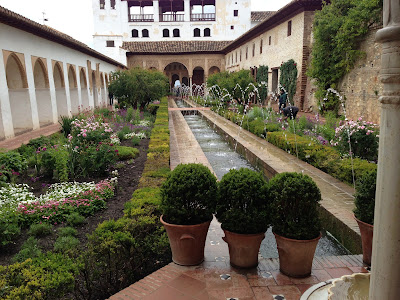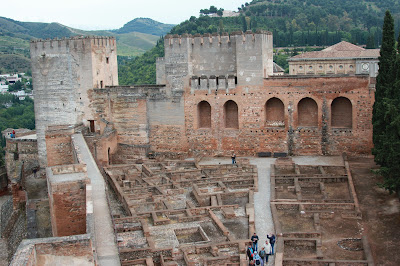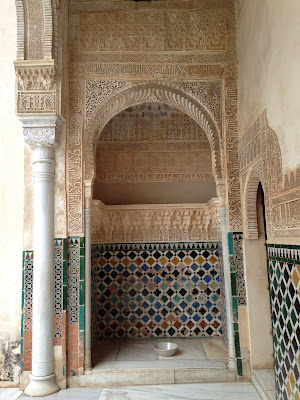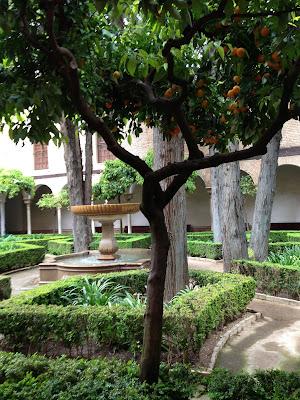First we pulled into the Alhambra parking lot which was right across the street from our hotel and parked, then walked over to Hotel Guadalupe. It was on a quaint little street with a few shops and restaurants overlooking the Alhambra. The hotel itself was lovely. (I must say, I did pretty good with booking the hotels this trip.) It had a fancy marble bathroom like the hotel in Madrid, and all the linens were monogrammed with the hotel name.
After we dumped our bags and put our feet up for 15 minutes, we decided to go explore the town. We needed to pick up our tickets for the Alhambra the next day. I had heard from my guide book that there was a kiosk down town that we could pick them up from, but our hotelier informed us there was also a kiosk right next to the Alhambra parking lot across the street from our hotel. (You have to reserve tickets at least 3 months in advance to get into the Alhambra, so it was a big deal to pick up our tickets before the kiosk closed.) So we headed over there and picked up our tickets, and then headed down the big hill towards the old town part of Granada.
We also had a package for a missionary who is assigned to Granada that we wanted to drop off at her piso (apartment). So we loaded it into our bag and were on our way. Our first view coming around a bend down the big hill was this:
It was absolutely breathtaking! I'm not sure there is a more beautiful city.
Our guide book had talked about walking down this hill, but daaang. It was steep and huge! We tried not to think about going back up it once we reached the bottom. :)
So I guess this is a good spot to give some background on Granada. It was originally settled by the Moors who ruled the Iberian (Spanish) peninsula from 700-1400 ish. They built a grand palace at the top of the hill (where our hotel is) and the king lived there and ruled the country from that spot. When the Christians conquered the Moors in 1492, they too fell in love with Granada and made it their capitol.
So it was in this city that Christopher Columbus came to King Ferdinand and Queen Isabel to ask for funding to sail to the New World. (We actually stood in the room where this happened! But more on that later...) And the Spaniards take great pride in Christopher Columbus and his expeditions. They have statues of him all over (even in Barcelona, but we'll get to that later as well).
When we got down to the old town part of Granada, we came to a beautiful plaza with a huge fountain and a statue playing out the King Ferdinand/Christopher Columbus scene.
The city was quaint and beautiful, with lovely architecture. It also has narrow streets and is so bustling that they restrict motorized vehicles to residents and public transportation vehicles only. This is one reason we opted to stay where we did. Lots of unknowing tourists drive around down in the town and then a traffic ticket shows up in the mail at their house weeks later! (Spaniards have the traffic camera thing down pat.)
This is who the city was named after.
Then we made our way to the Royal Chapel Cathedral down town. It was ginormous! I think it may have been the biggest cathedral we saw in Europe. I'm confident it was even bigger than the Notre Dame in Paris. This is where King Ferdinand and Queen Isabella are buried, as well as the King and Queen who succeeded them.
Unfortunately, we got to the cathedral about an hour after it had closed and we were so bummed. It may be one of the biggest regrets of our trip. I would have loved to go inside. If the outside was any reflection of the inside, I'm sure it would have been amazing.
The Royal Chapel Cathedral was SO big and the streets were so narrow that I really couldn't get a picture of the whole thing until the next day when I snapped one from up on top of a tower at the Alhambra. Then you can see how big it really is!
After we walked around the outside of the cathedral we walked through the Alcaiceria, which was originally a Moorish silk market with 200 shops. It smelled like spices and leather straight from Africa. Very cool.
Then we grabbed a pizza pastry and ate while we walked towards the missionary Piso to drop off this package. Unfortunately when we got there, we realized it was an apartment building with a locked lobby and buzzers, so we couldn't just leave the package on the porch. The missionaries weren't home (as we figured they wouldn't be), so we waited a while, went and got another pastry, waited another while, and then finally left to head back to our hotel. It had started to pour rain and was dark by this time, and we didn't know the neighborhood well enough to know we wouldn't get mugged. We trekked it back up the HUGE hill in the rain and then crashed at the hotel until the next morning. I think we walked more on this day than any other single day of our trip! Between Gibraltar and Granada's old town, we were sure pooped.
(And we mailed the missionary package from Barcelona back to this missionary, so no harm was done and no import taxes had to be paid. Yay!)
TUESDAY, MAY 21
We woke up bright and early, skipped breakfast and checked out of our hotel quickly. We dumped our luggage in our trunk and made it into the Alhambra by about 8:30 AM, which was great because there were hardly any crowds yet.
The grounds were beautiful and huge, over 75 acres. Paths like this one lined with trees are part of the free grounds that anyone can walk through.
They had more amazing orange trees! It wasn't the season for picking, so there weren't a ton on the trees but they were beautiful.
Once inside, we decided to head over to the Generalife Gardens and the summer palace. Just look at the view from the top of the hill up here!
Amazing.
The Generalife Gardens are where the Sultan's vegetable and fruit gardens were kept. He also had a small palace built up here where he lived in the summers, that was cool and quiet. All of the gardens are exquisitely manicured, and apparently look as close as they can get to any and all paintings they've found of the Alhambra in ancient times.
They even had an ancient ampitheater up here (I don't think I took a picture of it) where they still hold concerts. It would be such a beautiful setting for a concert.
They call this garden the closest thing on earth to the Quran's description of heaven. And it smells as amazing as it looks. All of these fountains are originals (or replicas of the originals) and are purely water-powered. The Moors were well known for their math, physics and astronomy. Some of their creations were very impressive.
This view is looking from the summer palace & gardens towards the big palace (Palacio Nazaries) and the fort & towers.
In the Islamic religion, it's forbidden to worship graven images, so the molding and tiling and stucco of the Alhambra are VERY ornate, but are all geometric shapes, flowers and nature. You won't find any animals or humans engraved anywhere. In my opinion, this is part of what makes it so lovely!
Can you imagine the work that went into some of these carvings?
From the top of the summer palace & gardens if you look in the opposite direction of the big palace, you can see the original Moorish wall climbing up the hill next to it. This is where the original city ended -- all 2000 inhabitants of the Alhambra lived within these walls.
Next we headed over to the Alcazaba Fort, passing various other buildings as we walked. They even have a Parador hotel located inside the Alhambra grounds. Can you imagine staying inside the Alhambra? Amazing. (And only $330 euros a night!)
Even the cobblestone paths of the Alhambra are impeccable.
Right outside the Alcazaba Fort was a peaceful-looking tree with benches underneath. I could have sat there all day.
The Alcazaba Fort is the oldest and most ruined part of the complex. What's left here is from the 13th century, but they have found evidence that an old Roman fort existed here before that.
A view of the tower before we climbed it. This is where they defended their city from. It seems like it would be a difficult place to sneak up on!
The views out over the city from here were unparallelled.
Look at the smile on that guy. A real live smile! This place was just way. too. cool. We couldn't even handle it.
There are a series of sprawling buildings here. It looks like some of the walls have crumbled and they've capped them with cement to keep them from further deteriorating.
A panoramic view from in between two of the towers.
Here is a view of the old town where we had walked the night before, as seen from the top of the largest tower. See that HUGE cathedral in the middle there? Yeah. That's the Royal Chapel Cathedral where Ferdinand & Isabel are buried. Man, I wish we'd been able to go inside. It's ginormous.
Some of the steps you had to climb to get up to the towers were a little scary!
Amazing, serene views.
Next we waited in line for the best part of the Alhambra -- the Palacio Nazaries. For this part of the tour, you not only have to schedule 3 months in advance but you have to choose a timeslot reservation, and if you miss it by more than 30 minutes you're out of luck. They won't let you in! That's how in demand it was.
The Palacio Nazaries is the Sultan's royal palace, or the "jewel of the Alhambra," as they say. The rooms inside are decorated top to bottom with wooden carvings, molded plaster walls, ceramic tiles and filigree windows. Here are a few pictures of the incredible details.
This is the Courtyard of the Myrtles. The Moorish women rarely went out, because they were supposed to be covered at all times. This courtyard was designed to give the royal women a chance to take in some fresh air without their husbands worrying about other men catching a glimpse of them.
This is some original Moorish tile flooring in the Grand Hall of the Ambassadors. I can only imagine how vivid and beautiful the colors were in its prime. This is where the sultan sat on his throne.
This is also where Isabel and Ferdinand sat on their thrones after the Spaniards conquered Granada in 1492. This is the very room where Columbus made his final plea for financing to sail across to the Orient, unrolling his maps and explaining plan to them.
(Fun fact! Incidentally, they didn't say yes to him in this room. After many hours of discussion that included numerous marine experts, scientists and mathematicians to double check Columbus's plans, Ferdinand and Isabel actually said no. Then as Columbus rode out of town Isabel and Ferdinand talked things over, they decided they weren't sure his calculations were correct but they didn't want anyone else to fund his expedition and claim the glory. So Ferdinand himself actually rode out of town and caught up with Columbus and agreed to fund his expedition on a dusty road somewhere outside of Granada.)
Many windows have wooden screens like these, which allowed the women to look out without being seen.
Here was perhaps our favorite room of the Alhambra -- the Courtyard of the Lions. The intricate carvings and columns were stunning.We found the fountain in the center of the courtyard to be very intriguing! It's sitting on the backs of 12 lions. Oddly familiar...
In Moorish times, the fountain was a sundial, with the mouth of one lion at a time spouting water in accordance with the changing time of day. (Remember that this was all purely water-powered.) After the Christians took over, some curious Spaniard took it apart in the 1500's to see how it worked and they've never been able to fix it. Amazing!
History has it that this fountain was a gift from a Jewish leader, with the 12 lions representing the 12 tribes of Israel. History also has it that the bowl in the center of the fountain used to have sides that came up higher -- like high enough for a person to stand in up to his waist. Fascinating!
These (original) columns have lead fittings between the pre-cut sections to allow things to flex and move during an earthquake. Isn't that amazing? Earthquake-proofing circa 900 AD. Amazing.
Next we walked through the Hall of the Abencerrajes. This was the sultan's living room, with an amazing ceiling based on the eight sided Muslim star. Apparently lots of power-struggles (i.e. murdering family members to obtain the throne) happened in this very room. Eeek.
Later in the day we walked through an exhibit detailing the restoration of the Alhambra, and showing the paintings that they used to recreate everything exactly as it was. It was very impressive to see how well kept is has been, and how painstaking they were in the restoration.
I started to lose track of which pictures were of which room after this...and it was then that we decided to buy a book of the Alhambra at the gift shop afterwards, with professional photos. It was the only book we bought our entire trip and it's pretty amazing.
A little more detail.
Some more original Moorish paint and tiles.
We walked through the room where the famous American author Washington Irving wrote the Tales of the Alhambra. He lived here in 1829 when the Alhambra was home to Gypsies and donkeys, and later became the US Ambassador to Spain. His book is what first kindled interest in the Alhambra and ultimately led to its restoration, and causing it to be recognized as a national treasure.
Here is the Hallway with a View. Wow. Can you imagine if this was your view every day? Amazing.
We passed through the Patio de Lindaraja before we exited the palace.
Another gorgeous orange tree!
After we exited we were dumped back into the paths between the palace and the summer gardens.
Okay, this was by far one of the funniest things we saw on our trip. Near the end of the palace tour was a big cardboard cutout (like you might find at a fair), where you could stick your face through and look like you were a Muslim. Politically correct? Definitely not! But what was hilarious was that as we passed, we caught three actual Muslims, dressed in Muslim garb (hard to see because the visible one taking the picture has a jacket over his clothes), putting their faces through the cardboard to look like Muslims. They were laughing and having a good time.
Muslims taking pictures of themselves dressed as Muslims. Oh my, we laughed at that for a good while. And I think they did too.
There were a few smaller buildings under renovation, but we were able to see their pools from the outside.
And lastly, we toured Charles V's Palace. After the Christian's took over, you better believe they came in and built their own palace right on top of the Moors' palace. (Just like everyone else in Europe did for thousands of years.) Palacio Nazaries wasn't good enough for Charles V so he commissioned this new home by taxing Granada's defeated Muslim population. It was commissioned to be built by Pedro Machuca, who was a pupil of Michaelangelo. It is considered one of Spain's most impressive Renaissance buildings, with a circle in a square design. But honestly? After walking through the Alhambra, this place was totally underwhelming!
Luckily the basement held the Alhambra museum, where some of the actual surviving Alhambra art is stored (some of the pieces on display are now replicas -- like the lions holding the fountain). The basement also held the exhibit about the restoration of the Alhambra and the man who directed it, and it was absolutely fascinating.
There is an old Spanish saying about a man passing a beggar on the street that says, "Give him a coin, woman, for there is nothing worse in this life than to be blind in Granada." And my goodness, amen and amen to that.
After a quick late-afternoon lunch in our hotel lobby, we hopped in our car to make the 5-hour drive to Valencia to, drum-roll-please, meet up with my parents! I could hardly contain my excitement!!
To be continued in Valencia & Sagunto...




































































































No comments:
Post a Comment